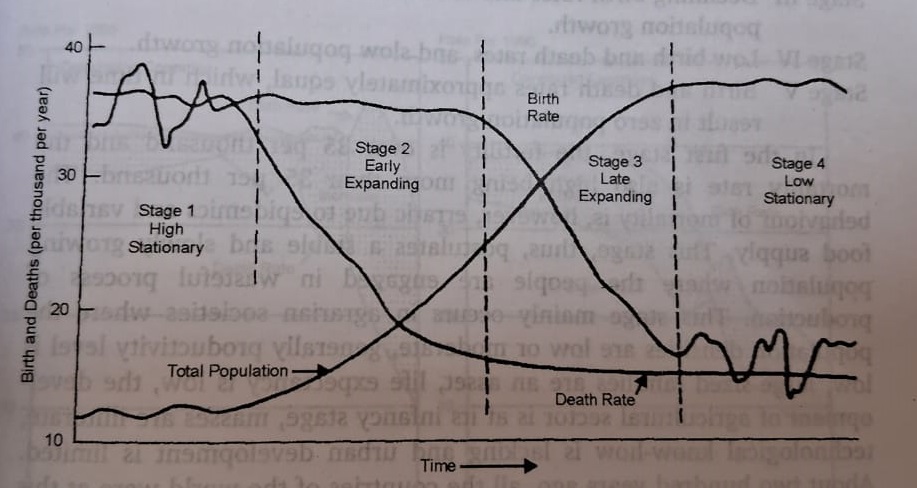The study of world population is central to understanding global patterns of development, resource use, and environmental change. The growth and distribution of population are influenced by a complex interplay of physical, economic, social, and political factors. While some regions of the world are densely populated and growing rapidly, others experience slow growth or even population decline.

Table of Contents
Growth of World Population
Historical Growth Trends
The growth of the human population has not been uniform throughout history:
- Prehistoric Period (Before 8000 BCE): Human population grew very slowly due to high death rates, disease, and food scarcity.
- Agricultural Revolution (8000 BCE – 1750 CE): Gradual growth as agriculture allowed food surpluses.
- Industrial Revolution (1750 – 1950): Marked a significant rise in population due to better food production, sanitation, and healthcare.
- Post-1950 Period (Population Explosion): Rapid population growth, especially in Asia, Africa, and Latin America due to reduced mortality rates and improved medical care.
Current Status
- As of 2024, the global population is over 8 billion.
- The annual growth rate has slowed from 2.1% (1960s) to about 0.9% (2020s).
- Growth is high in developing countries and low or negative in developed countries.
Factors Affecting Population Growth
- Birth Rate: Higher in less developed regions due to social and economic factors.
- Death Rate: Lowered by medical advancements and public health systems.
- Fertility Rate: Cultural and religious norms, education levels, and gender roles influence fertility.
- Migration: Affects local and regional population sizes but has limited impact globally.
Distribution of World Population
The global population is unevenly distributed:
High-Density Regions
- South Asia (India, Bangladesh, Pakistan): Fertile river valleys, monsoon agriculture.
- East Asia (China, Japan): River basins and coastal areas.
- Europe: Especially Western and Central Europe.
- Southeast Asia: Indonesia, Philippines – agricultural and trade hubs.
Low-Density Regions
- Deserts: Sahara, Arabian Desert – extreme climates.
- Mountains: Himalayas, Andes – harsh terrain and inaccessibility.
- Tundra and Polar Regions: Low temperatures and permafrost.
- Rainforests: Amazon and Congo basins – dense vegetation, poor soils.
Factors Affecting Population Distribution
Physical Factors
- Climate: Moderate climates attract more population.
- Topography: Flat, fertile plains are preferred.
- Soil and Water: Areas with fertile soil and freshwater sources support agriculture and settlement.
- Natural Hazards: Earthquakes, floods, and hurricanes discourage dense settlement.
Human Factors
- Economic Opportunities: Urban and industrial centers attract migrants.
- Political Stability: People avoid conflict zones.
- Infrastructure: Better transport, education, and healthcare draw people.
- Historical and Cultural Factors: Ancient civilizations and trade routes influenced settlement.
Demographic Transition and Population Growth
The Demographic Transition Model (DTM) explains changes in population growth based on economic development:
- Stage 1 – High birth and death rates (pre-industrial societies)
- Stage 2 – Death rates drop (improved health, food)
- Stage 3 – Birth rates fall (urbanization, education)
- Stage 4 – Low birth and death rates (developed societies)
- Stage 5 – Declining population (some European & East Asian countries)

Impacts of Uneven Population Growth
- Overpopulation: Pressure on land, water, food, and jobs.
- Urbanization: Rise of megacities, slums, and traffic congestion.
- Environmental Stress: Deforestation, pollution, and biodiversity loss.
- Migration Pressures: Rural to urban migration and international migration.
- Aging Populations: In Europe and Japan, fewer workers and rising healthcare costs.
Conclusion
The growth and distribution of the world population are dynamic and multidimensional. While population growth is stabilizing globally, regional imbalances continue to pose significant economic, social, and environmental challenges. Understanding these patterns is essential for planning sustainable development, managing resources, and ensuring equitable growth in the future.
Read: Geography Notes